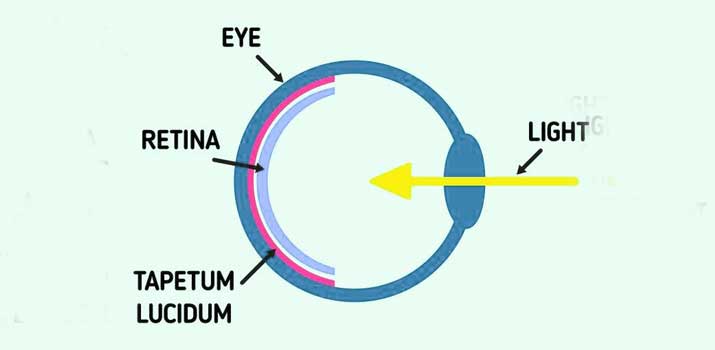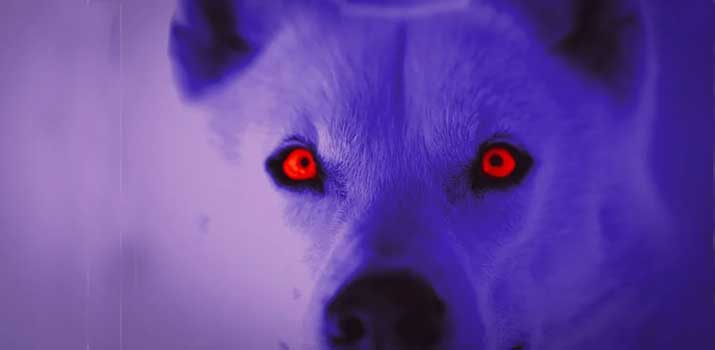
Picture this:
You take your precious angel of a dog out for a late-night bathroom session. They run out to the backyard and go far away from you in the pitch-black darkness.
To ensure they're safe, you whip out your flashlight and shine it their way. When you finally spot your dog, it looks up at you with creepy-looking glowing eyes!
Sound familiar? It's something that many new dog owners experience. You get used to seeing those glowing eyes, but one lingering question may remain for years:
Why do dog eyes glow in the dark?
Canine Ocular Biology
To understand why those somewhat demonic-looking glowing eyes occur, you must know a little bit about the biology of a dog's eye.
First things first: Dog eyes are much different from your own. You might see a furry companion with vibrant blue eyes that look strikingly similar to that of humans. But inside? It's completely different.
That's because dogs have one distinct skill humans lack: Night vision!
Long before they were spoiled domesticated pets, dogs needed the ability to see at night.
They roamed the earth, scavenging for food at all hours of the day. Not only that, but they had predators that didn't wait for sunlight to make a move.
Nightvision is an evolutionary trait that developed millions of years ago in many mammals and is still around in most domesticated dogs.
So what does that have to do with glowing eyes?
Well, nocturnal animals and Cathemeral creatures that stay can be active night and day, like your dog, have a reflective layer in the back of their eyes. It's called the tapetum lucidum.
Also known as simply the "tapetum," this layer of reflective tissue is what makes night vision possible. It contains riboflavin and zinc.
Riboflavin is an amino acid, while zinc is an essential metal mineral. Both act as reflective agents.

The tapetum sits in the rear of the eye, between the optic nerve and the retina. Its job is to bounce light around the eye so the visual cells can pick up as much information as possible.
The visual cells are made up of rods and cones, which are essential in giving your dog night vision powers.
The rods are better suited for low-light conditions. Humans also have rods and cones. But the concentration of rods to cones is much higher in dogs. It's even higher in cats, giving them more powerful night vision capabilities than your dog!
Of course, those visual cells can't do their job unless light passes over them. That's where the tapetum comes in. Think of it as a concave mirror.
Light already moves through the cells, but the single pass doesn't provide much visual information to pick up. The tapetum forces light to bounce around, effectively creating a second pass over the cells.
That process delivers all the information your dog needs to navigate dark environments.
Related read: Dog’s Eye Got Scratched by a Cat?
When Do Glowing Eyes Occur?
When you see that signature ocular glow, it's nothing more than light reflecting from the tapetum. The light is bouncing out of the eye and right back to you. It's a perfectly normal, albeit sort of creepy, phenomenon.
You're most likely to see this when you're shining light directly at your dog. You might notice subtle glowing if you catch the eye at an angle.
But let's face it: Dogs have a knack for staring directly at you during any interaction. So those sudden head turns in your direction make the glowing eyes come out in full force!
You can also see them when taking photos. It's like when humans have red eyes in pictures, but the color isn't always red—more on that in a second.
If the glowing eyes are a problem when taking photos, turn off the flash!
Alternatively, you can have someone distract your pup, so they're not looking directly a the camera. That should fix the issue and make your dog look less otherworldly!

Also read: How to Tell if your Dog is Going Blind?
Do All Dogs' Eyes Glow the Same?
The tapetum is a unique biological feature. Like anything else on a dog, it doesn't develop exactly the same way in every dog. It's another thing that makes your pup unique!
Some dogs have a larger tapetum than others. Furthermore, the cellular makeup can vary. Remember: The tapetum tissue gets its reflectivity from zinc or riboflavin.
In some dogs, the tapetum has more zinc. Others might have more riboflavin, while others have a healthy mix of both.
Interestingly, some dogs don't have tapetum at all! Recent estimates show that around 1.9 percent of dogs lack the tapetum. It's a small percentage, but they exist.
As you probably guessed, those dogs don't have night vision. But their eyes can still glow in the right conditions as light reflects off the blood vessels in the back of the eyes!
Overall, the color of that signature eye glow varies based on the cellular makeup of your dog. Factors like breed, eye color, and coat color come into play.
Canine Eye Reflection Color Chart
So what color can you expect to see from your dog's eyes?
Below is a general color chart to give you a better idea of the color variation. It includes some popular breeds and coat colors. These colors are the norm. However, there are no guarantees.
There are some canine outliers with unique tapetum tissue. If anything, use this color chart as a loose guide rather than concrete scientific evidence.
- Siberian Husky – Red glowing eyes
- Schnauzer – Blue or turquoise glowing eyes
- English Springer Spaniel – Orange glowing eyes
- Yellow Labrador – Soft yellow glowing eyes
- Black Labrador – Deep yellow or green glowing eyes
- White-coated dogs – Red glowing eyes
- Dogs with blue irises – Red glowing eyes
What About Puppies?
Curious about puppies? If you spend a lot of time around young dogs, you know that their eyes change dramatically as they grow. You can't even see their eye color at birth because they keep them close for several weeks!
When they finally crack those eyes open and look into the world for the first time, the eyes are noticeably brighter than adults of the same breed.
The eyes lack pigmentation for several months. Eventually, they develop into the dog's "true" eye color. As you can imagine, the color of the reflected glow differs, too.
The glow is usually the same as blue-eyes dogs when the eyes are light and pigment-free. It's orange or red. The color will gradually change over several weeks and months.
By the three-month mark, most puppies are at their final color. The same goes for the reflected glow.
Glowing Eyes: A Necessary Canine Biological Function
There you have it! You finally have an answer to a question you've thought about every time you've taken your dog out late at night.
That creepy glow is perfectly normal and comes from the unique ocular characteristics that give your pooch night vision.
It's a fascinating piece of biological knowledge you can continue exploring with every dog you meet. Take a look at those peepers and refer to our color chart to see what their glow color might be!
Also Read: Why Does my Dog Sleep with His Eyes Open

